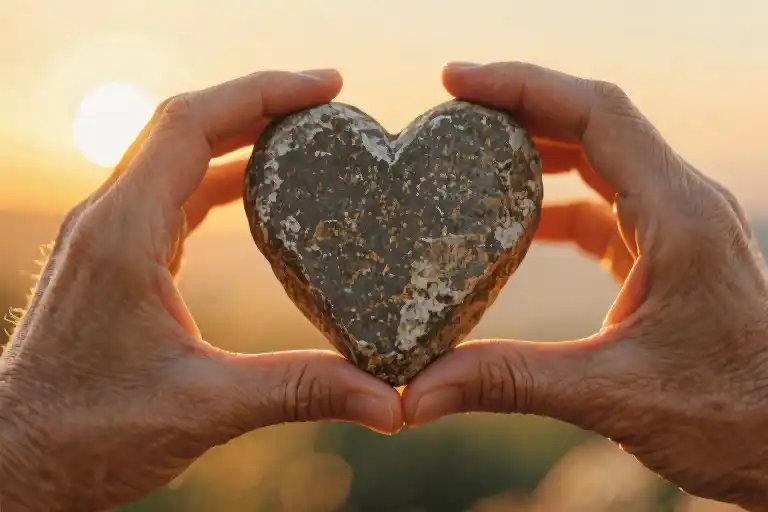I used to believe love was a feeling—something that hits you like a summer storm, all thunder and lightning and quickened pulses. That was before I met someone who lingered long enough to teach me the difference between weather and weathering.
Feelings, I’ve learned, behave like meteorological events. They come in gusts—the flutter of attraction, the warmth of infatuation, the hailstorm of early arguments. They pass through us, leaving us either drenched in joy or shivering with doubt. But weathering? That’s the slow shaping of coastlines by persistent tides. The way tree rings accumulate stories only time can tell. The silent transformation of a locked door when the right key finally turns.
There was no cinematic moment when it happened. No orchestral swell or perfectly timed meet-cute. Just a Tuesday when I noticed he’d started buying my preferred brand of toothpaste without being asked. A Thursday when his silence during my anxiety attack felt more comforting than any platitudes. The ordinary miracle of someone learning your emotional grammar so thoroughly they can read between your unspoken lines.
Real love doesn’t announce itself with fireworks. It whispers through a hundred mundane acts of staying:
- The way he folds laundry like it’s a love letter
- How his coffee orders evolve to “whatever she’s having”
- That particular sigh he makes when massaging my temples after long days
This is what no one prepares you for—that the deepest love often wears the plainest clothes. It shows up carrying groceries instead of roses, speaking in commas rather than sonnets. And when storms come (as they always do), it doesn’t promise sunshine. Just steady hands holding the umbrella at precisely your angle.
Perhaps this is the truth we’re never told: love isn’t about falling. It’s about learning to stand together while everything else keeps changing.
(Your turn: When did you first recognize weathering love in your life? Was it in a grand gesture or something barely noticeable?)
Fireworks Burn Out: What We Get Wrong About Love
We’ve been sold a story about love that sparkles and fizzles like champagne. The kind that hits you like a lightning bolt, with violins swelling in the background and time slowing down when your eyes meet across a crowded room. Romantic comedies taught us to measure love by butterfly counts and grand gestures – the bigger the bouquet, the deeper the affection.
But neuroscience tells a different story. That initial rush of dopamine, the chemical responsible for romantic euphoria, typically lasts between 12 to 18 months. Like fireworks against a night sky, it’s dazzling while it lasts, but the darkness always returns. A 2022 study from the University of California found that 78% of couples experience significant emotional turbulence when this ‘honeymoon phase’ ends, mistaking the natural progression of attachment for fading love.
Consider how we document relationships now: Instagram proposals with choreographed dances, TikTok compilations of anniversary surprises, Pinterest-perfect date nights bathed in fairy lights. These curated moments create unrealistic expectations, making the ordinary magic of daily companionship seem inadequate by comparison. The truth is, real lasting love rarely looks good in a 15-second clip. You can’t capture weathering love in slow motion because it moves at the speed of grocery runs and laundry days.
Which romantic myths do you most want to dismantle? Is it the idea that soulmates never argue? That true love means constant excitement? That if you have to work at it, it’s not ‘meant to be’? These narratives do more than disappoint – they cause us to abandon good relationships when the glitter settles, always chasing the next high.
I used to believe love should feel like standing under a waterfall – overwhelming, all-consuming. Now I understand the deeper miracle lies in the quiet persistence of water shaping stone. Not the dramatic splash, but the patient wearing away of rough edges until two surfaces fit together without force. That’s weathering love: less about falling, more about learning to stand together through all seasons.
The Anatomy of Weathering Love
We’ve been sold a lie about love. The kind that comes wrapped in grand gestures and scripted moments, where every conflict resolves before the credits roll. Real weathering love operates differently—it’s less about the spotlight and more about the backstage work that keeps the show running.
The Three Pillars
1. The Art of Containment
That crumpled tissue you shredded during last week’s anxiety attack? A lesser love would’ve seen clutter. Weathering love sees a map of your nervous system and quietly smooths out the paper scraps while making tea. It’s not about fixing, but about holding space for the unfixable parts of you.
2. Domestic Alchemy
Notice how the most ordinary acts become sacred rituals:
- The way he memorizes your medicine dosage like it’s poetry
- How she always leaves the porch light on when you’re late
These aren’t chores—they’re love letters written in the ink of routine.
3. Fracture Repair
Every relationship develops cracks. Weathering love doesn’t pretend they don’t exist—it develops a sixth sense for when the seams need mending. That midnight conversation after your stupid fight wasn’t about who was right; it was about proving the ‘we’ matters more than the ‘me.’
Case Studies in Ordinary Devotion
The Pharmacist Boyfriend
When fever had you shaking at 3AM, real love looked like:
- Him squinting at the tiny print on your allergy meds
- Creating a color-coded chart for your vitamins
- Leaving water and pills on your nightstand before his morning run
No dramatic declarations—just meticulous care that said “I plan to be here for all your tomorrows.”
The Laundry Linguist
She could’ve bought flowers. Instead, she learned:
- Your shirts get folded inside out
- That one sweater must lay flat to dry
- How to remove red wine stains from cotton
A masterclass in love as attention to the unglamorous details.
This is weathering—the quiet accumulation of a thousand forgettable moments that somehow become unforgettable. Not because they’re extraordinary, but because they’re yours.
The Silent Grammar of Love
We spend so much time analyzing love’s grand declarations that we miss its quiet syntax. That moment when he reaches for your hand without looking up from his book. The way she automatically shifts her umbrella to cover your shoulder when it rains. These aren’t just behaviors – they’re an entire unspoken vocabulary.
Psychology tells us 93% of emotional communication happens through micro-expressions and body language. The raised eyebrow that says “I know you’re anxious” before you’ve spoken. The coffee cup placed deliberately within your reach on sleepy mornings. Real love builds its own sign language, where grocery bags become love letters and yawns turn into sonnets.
Your Weathering Lexicon
Try this: for one week, document three “punctuation moments” – those small gestures that subtly shape your emotional dialogue:
- The Comma Pause
When they stop scrolling to really listen to your rambling story - The Parenthesis Embrace
How their arms create a safe space around your fragility - The Ellipsis Glance
That look across a crowded room that says “I’ll find you later”
These aren’t romantic grand gestures. They’re the subconscious grammar of weathering love – the syntax that holds relationships together when feelings fluctuate. Notice how the most meaningful ones often happen when you’re least “lovable”: when you’re snapping about traffic, or crying over burnt toast, or wearing yesterday’s mascara.
What makes these moments extraordinary is their ordinary context. The neuroscience behind this is fascinating – our brains actually register these micro-moments as emotional security deposits. Each one strengthens what psychologists call the “relational immune system,” that invisible infrastructure that helps love survive life’s inevitable storms.
So tonight, pay attention to the silent conversation happening beneath your words. The way his fingers linger an extra second when handing you the wine glass. How she tucks the blanket around your feet during movie night without interrupting the plot. This is weathering love’s mother tongue – fluent in the dialect of small salvations.
Your turn: What’s one “punctuation moment” you’ve overlooked today?
The Weathering Toolkit: Turning Observations into Actions
Most relationship advice stops at recognition—the moment you nod and think yes, that’s exactly how love should feel. But weathering love isn’t about passive awareness; it’s about building daily rituals that transform fleeting insights into enduring patterns. Here’s how to move from noticing those grocery-carrying, punctuation-listening moments to actively creating them.
The 5-Minute Detail Retrospective
Real intimacy often fails not from lack of grand gestures, but from overlooked micro-opportunities. Try this conversation template during mundane moments—while loading the dishwasher or waiting for coffee to brew:
- Anchor: “I’ve been thinking about that thing you did yesterday…” (Specificity is key: “when you realigned my crooked picture frame” beats “you’re thoughtful”)
- Dig: “What was going through your mind then?” (Most weathering acts are unconscious; this makes the invisible visible)
- Mirror: “So when you , it makes me feel “ (Connects action to emotional impact without performative gratitude)
This isn’t relationship homework—it’s archaeology for the ordinary. As psychologist John Gottman found, couples who consistently acknowledge “small things often” build emotional savings accounts that weather inevitable storms.
Weathering Through Conflict: Three Phrases That Matter More Than “I Love You”
True weathering reveals itself not in harmony, but in repair. When tensions rise, these unsexy phrases do the heavy lifting:
- “I’m angry but I’m not leaving” (Combines emotional honesty with commitment—the hallmark of secure attachment)
- “Help me understand your punctuation” (Extends the listening metaphor during misunderstandings)
- “We’ve survived harder” (Activates shared history as resilience fuel)
Notice these aren’t conflict-resolution scripts. They’re linguistic levees—structures that contain floods while allowing necessary erosion. The difference between destructive storms and landscape-shaping weathering often comes down to these micro-interventions.
From Toolkit to Touchstone
Tools gather dust unless integrated into daily rhythms. Try this:
- Designate a weathering witness—a notes app folder or physical jar where you deposit observed moments (“Tue: She reheated my coffee without asking”)
- Monthly, review these not as romantic trophies but as behavioral blueprints (“His consistent _ makes me feel _“)
- Before major decisions, ask: Does this choice reflect our weathering style or temporary weather?
What makes weathering love radical isn’t its poetry, but its practicality. It’s choosing to see the act of remembering how they take their tea as infrastructure work—the unglamorous pilings that keep the whole structure standing when the winds change.
Your turn: What’s one weathering phrase or ritual that’s held your relationship together? Share it with #WeatheringToolkit—let’s build this resource together.
The Quiet Grammar of Love
We spend our youth collecting fragments of love from movies and novels—the grand gestures, the orchestrated coincidences, the swelling music that accompanies first kisses. Then one morning you wake up to find someone has rearranged your mental furniture without permission. They’ve replaced those glittering shards with something heavier and warmer, like swapping costume jewelry for a river-smoothed stone that fits perfectly in your palm.
This is weathering love: the antithesis of fireworks. Where romantic comedies teach us to chase explosions, real intimacy thrives in the absence of spectacle. It’s the safety of knowing your partner will:
- Fold the laundry wrong (but always remember your allergy medication)
- Hum off-key in the shower (while letting you have the hot water first)
- Text “saw these and thought of you” with a blurry photo of mangos (when you never even mentioned liking mangos)
Psychologists call this “attunement”—the ability to notice and respond to a partner’s unspoken needs. Like how he learned to leave one kitchen cabinet slightly ajar because you always forget where the coffee mugs live. Or how you automatically tilt your phone screen away during movies since his light sensitivity developed last winter. These aren’t plot points in any love story, yet they build something more durable than passion ever could.
The weathering test: Next time you’re together, notice how many silent adjustments happen. The way coats get hung on “your” side of the hook, how toothpaste tubes get recapped without discussion, the unspoken agreement about who handles spiders and who deals with burnt toast. These micro-rituals form the hidden syntax of lasting love—a language without flashcards where fluency grows through shared mornings and exhausted evenings.
Your weathering moment: When did you first realize your relationship had developed this private vocabulary? Was it the first time they handed you a sweater before you felt cold? Or when you stopped keeping score of who last took out the trash?
Three Books That Understand
- The Relationship Cure by John Gottman
Decodes how mundane interactions (like rolling your eyes at bad puns) predict relationship longevity better than dramatic declarations. - Attached by Amir Levine & Rachel Heller
Explains why feeling “bored” might actually signal secure attachment—the neuroscience behind weathering love. - The Art of Gathering by Priya Parker
Surprisingly relevant for couples; teaches how to craft meaningful ordinary moments (even Tuesday night leftovers).
Join #WeatheringMoments—share the unremarkable, irreplaceable instant you knew this was different. Not because it sparkled, but because it held.





